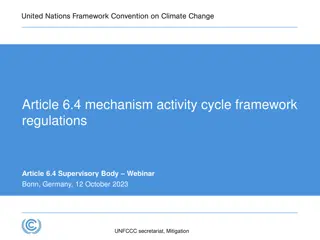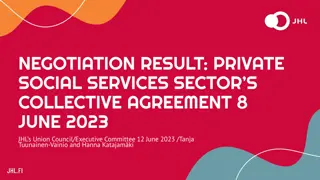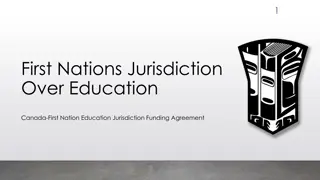Understanding Article 6.2 Activity Cycle in Paris Agreement
Exploring the operationalization of Article 6.2 of the Paris Agreement through a private training series, this program focuses on capacity building for implementation and covers key aspects like the activity cycle, authorization processes, roles of governments, and project-level requirements. It delves into defining requirements for activity design, implementation, and verification, emphasizing environmental integrity in international transfers within the cooperative agreement framework.
Download Presentation

Please find below an Image/Link to download the presentation.
The content on the website is provided AS IS for your information and personal use only. It may not be sold, licensed, or shared on other websites without obtaining consent from the author. Download presentation by click this link. If you encounter any issues during the download, it is possible that the publisher has removed the file from their server.
E N D
Presentation Transcript
Operationalizing Article 6.2 of the Paris Agreement: Private Training Series Capacity Building Program for Article 6.2 Implementation and operationalization
Operationalizing Article 6.2 of the Paris Agreement: Private Training Series Session 2 Johan Nylander Neyen Consulting
What we will cover today: Quick recap: The Art. 6 activity cycle potential Art. 6.2 activities in relation to country NDCs Quick recap: What is authorization? Deep dive: Should countries have a separate process for approval and authorization? Or, both in one? Deep dive: The new and expanded role of governments in aggregating mitigation activities Case study: Setting project-level requirements 3
Article 6.2 Activity cycle - definition Once an Art. 6.2 strategy is in place, both the issuing and receiving Parties need to define the requirements for an Art. 6.2 Activity design, implementation and verification to ensure environmental integrity at the activity level is preserved. The requirements for Art. 6.2 activities for international transfer are to be established by the participating countries within the framework of the Article 6.2 guidance (Decision 2/CMA3 and future CMA decisions). The approach, standard, or mechanism used is, therefore, to be determined by the countries in the cooperative agreement. The process or cycle an Art. 6.2 activity goes through from early design to ITMO authorization is often called activity cycle. 5
Article 6.2 Activity cycle Steps: 1. Eligible Act. 6.2 activity Inputs: Positive-negative lists. Calls for proposal requirements. 2. Prepare concept note/pre-design documentation (e.g. PIN, MAIN or similar) Inputs: first estimation of ER taking into account baseline and accepted accounting methodologies Demonstration of being additional to the level of ambition of the NDC 3. Detailed design (PDD, MADD, check name given by Sweden for example or Japan) Calculation of reference level/baseline and estimated ER Design of the monitoring and reporting plan in line with accepted methodologies/protocols 4. Registration 5. Validation 6. Approval or pre-authorization 7. Monitoring and verification 8. ITMO authorization 6
Article 6.2 Activity cycle - process When there is bilateral agreement: Host country and receiving country may have different requirements for Art. 6.2 activities. Countries need to agree, among others, on: Emissions reduction accounting methodologies (baseline and actual emissions monitoring) accepted. The documentation required from each Art. 6.2 activity from preliminary design and detailed design to periodic reporting of emissions reductions. If and how the information in the documentation is to be validated before an activity registration and/or approval If there will be a formal approval or pre-authorization of the mitigation activity after validation of the required documents. A verification process for monitoring data that can form the basis for issuance and authorization of ITMO use and transfer. Example of activity cycle: https://www.energimyndigheten.se/globalassets/klimat--miljo/internationella-klimatinsatser/terms-of-reference.pdf 7
What do we mean by authorize the use or transfer of an MO activity? 8
Authorization - definition The interpretation of the authorization requirements under Art. 6.2 is evolving. Authorization is required for: ITMOs for a use i.e. towards the achievement of an NDC or towards other international mitigation purposes (OIMP) The Participating entities in cooperative approach cooperative approach Authorization of use of ITMOs is a key step in the Article 6.2 process since it gives the buyer country rights to claim the ITMO and use it to its own NDC. 9
Approval content (suggested) Remember: Activity approval and authorization are not the same General information: date; number of approval; Party; Issuing authority, contact information and elements for authentication; Details of the mitigation activity, including but not limited to sector of activity, technology, crediting period Reference to accounting methodology for baseline and emissions reductions calculations. Monitoring requirements. Confirmation and information on how the activity contributes to sustainable development in the host country An explanation of how the activity contributes to the implementation of the NDC and the purposes referred to in Article 6, paragraph 1. Reference to the purpose of future ITMOS authorization> for NDC use of other international mitigation purposes. Authorization of participating entities, a signal that they would be able to claim mitigation outcomes and later request authorization and transfer of ITMOs. Reference to, as appropriate, share of proceeds (SoP) provisions and overall mitigation of global emissions (OMGE) Link to a public repository of the approval. 10
Authorization content (suggested) What can an authorization contain? General information: date; number of approval; Party; Issuing authority, contact information and elements for authentication; Details of the mitigation activity, including but not limited to sector of activity, technology, crediting period Reference to accounting methodology for baseline and emissions reductions calculations. Cooperative approach from which MOs/ITMOs are authorized; Amount and details of MOs/ITMOs authorized towards NDC; Amount and details of MOs/ITMOs authorized towards OIMP and authorized entities (in a manner that enables linking the MOs/ITMOs to tracking information); NDC implementation period; Authorized entities, including scope of authorization; Special condition applicable to the authorization, including permissible changes and cancellation, if envisaged; Applicable share of proceeds (SoP) and overall mitigation of global emissions (OMGE) provisions. Link to a public repository of the authorization; 11
Reminder: Authorization & CAs When ITMOS from an Art. 6 activity are authorized by the government For NDC For OIMP It will trigger corresponding adjustments (CA) 12
Deep dive: should countries have a separate process for authorization vs. approval?
Authorization vs. approval process It might be useful to have separate processes for activity approval and for the authorization of the use of mitigation outcomes from the activities. Why? A differentiation between the approval of the activity and the authorization of the first transfer of ITMOs is the approach taken in the process for the Article 6.4 mechanism (decision 3/CMA.3 Annex. Section C). This distinction allows for the separation of the approval of: Processes that approve a specific activity (project) Volume of mitigation outcomes transferred from the activity Vs. 14
Authorization vs. approval process However, there are also some drawbacks: The distinction between approval and authorization processes may also mean higher transaction costs and uncertainty for investors and activity participants, as well as higher implementation costs for the transferring country. Timing is not the same for all types of actors Private sector participants counting on carbon finance as part of the financial package need this decision up- front. Public sector participants, e.g., implementing a sectoral intervention, may get the decision to authorize the transfer of mitigation outcomes after the sectoral intervention has achieved mitigation outcomes beyond a target. The authorization of participants should give the implementer/developer an indication of the number of mitigation outcomes that they can claim as ITMOs. 15
Case study: Setting project-level requirements
Setting project-level requirements Parties engaging in cooperative approaches may choose to determine the type of collaboration that they are willing to undertake, the freedom freedom to to define define the the type type of of collaboration collaboration. . the Article Article 6 6. .2 2 guidance guidance give give them them large large Transferring and receiving countries are to define activities activities to to ensure ensure that that environmental environmental integrity for for cooperation cooperation are are reached reached. . define different different requirements integrity is is preserved preserved and requirements for and that that the the national for Article Article 6 6. .2 2 national objectives objectives Countries may do this unilaterally the the negotiation negotiation of of the unilaterally in in the the cooperative cooperative approaches the process process of of seeking approaches. . seeking activities activities to to support, support, or or during during 17
Setting project-level requirements As an example, Sweden has set out specific project requirements in calls for proposals for projects that will be used under Article 6.2. Other methods for setting project-level requirements are the use of positive lists for project identification, or the use of screening tools like the MAAP (Mitigation Action Assessment Protocol). The requirements set out by Sweden are categorized into the following areas: Activity Activity type type - transformativeimpact . Transaction Transaction vintage, volume, etc. Technology Technology and and sector sector allowable technologies. Environmental Environmental integrity integrity quality, additionality, methodology. Host Host country country party status. Ambition Ambition OMGE, raising ambition. Proponent Proponent capacity of proponent. 18
Setting project-level requirements Another option is to develop a positive and negative list. Host countries will choose to use positive lists to define the activities that go beyond an NDC (conditional). For countries without a conditional target, these activities will be defined to be outside of the scope of the activities already defined under the unconditional part of the NDC. For example, the activities must: Include non-common technologies or practices. Otherwise challenging to finance. Fit specific high-hanging fruit sectors or technologies. Support sustainable development. Etc. 19
Setting project-level requirements Some countries at the forefront of Article 6.2 implementation are setting out different criteria for the creation of a positive list. One such example is Ghana, which identifies a number of criteria for projects to be developed as ITMOs for international transfer. These criteria are then translated into a positive pre-selected list of eligible activities, which may be eligible to be automatically approved. Ghana includes a specific positive list (activities from the conditional component of the NDC) and a pre-selected list for 2022-2025. 20
Ghana pre-selected 2022-2025 list Waste: o Landfill gas management o W2E (waste to energy) technologies o Composting of organic waste Renewable energy: o Distributed solar photovoltaic technologies o Off-shore wind technologies o Micro/pico-hydro o Biomass gasification/biogas o Solar photovoltaic mini-grids Sustainable cooking: o High-efficiency improved biomass o LPG cooking stoves 21
Additional requirements (Ghana) Category Environmental integrity Does not lead to an increase of GHG emissions Sustainable development Must use the Sustainable Development Co-benefits Tool 30 or SDG impact assessment tool Obtained and environmental permit under Ghana s Environmental Impact Assessment Legislation General Eligibility Shall come from inside or outside the scope of Ghana s NDC, and include: Criteria MO activities should document sustainable development co-benefits Reductions and removals GHG mitigation co-benefits of adaptation actions specified in the NDC Economic Diversification Plans and means to achieve them Activities defined by Ghana and the Paris Agreement or Cooperating Party in recognition and consistent with Article 6.2 guidance 22
Deep dive: The new role of governments aggregating mitigation activities
The new role of governments aggregating mitigation activities What is the role of government in aggregating mitigation outcomes? Now, governments can take on a bigger role in identifying and promoting mitigation activities. Otherwise, there is a risk of lack of supply if the government does not adequately promote and facilitate mitigation activities, therefore not meeting a cooperative agreement. This is relevant in cases where the private sector would not have an incentive to participate due to low commercial viability (e.g. micro scale activities) 24
How can this be achieved? New concepts have emerged, such as climate auctions: Innovative public climate finance mechanism, with high potential to support NDC implementation through cost-effectively leveraging private investment. They are composed of 3 elements: Products: Products: the sale of price guarantees for climate assets. Climate assets are (tradable) units that represent specific climate- outputs or outcomes, such as emission reductions, energy efficiency savings, or renewable energy. Risk sharing: Risk sharing: the owner of the option contract is only allowed to make use of the fixed price guarantee if a third party verifies that the owner has satisfactorily delivered the climate asset. Price formation Price formation: the price paid for the guarantee is determined by an auction format where multiple bidders compete to own the contract; and 25
Case study: the Pilot Auction Facility (PAF) The PAF sold tradeable price guarantees, in the form of options contracts, to support abatement. To date, there have been three PAF auctions, with the first two focusing on methane abatement from landfills and the most recent auction focusing on nitrous oxide abatement from nitric acid production. Together, the three auctions have allocated US$54 million in climate finance to reduce 21 MtCO2e, with bidders paying US$13 million in premiums to acquire the options. The net cost of the mechanism to the auction funders has been just over US$ 2/tCO2e. 26
15 minutes: Q&A
Next: Open discussion questions
Questions for open discussion: Question 1 What are the main requirements, from a private sector perspective, when deciding to invest in Art. 6 activities in your country? What do developers need and expect from authorization / approval processes? Question 2 What are the biggest risks for private sector developers to develop Art. 6 activities? Question 3 What could the benefit be from registering an activity under Article 6.2 (with corresponding adjustments) compared to register it as a "normal" voluntary market project? 29























